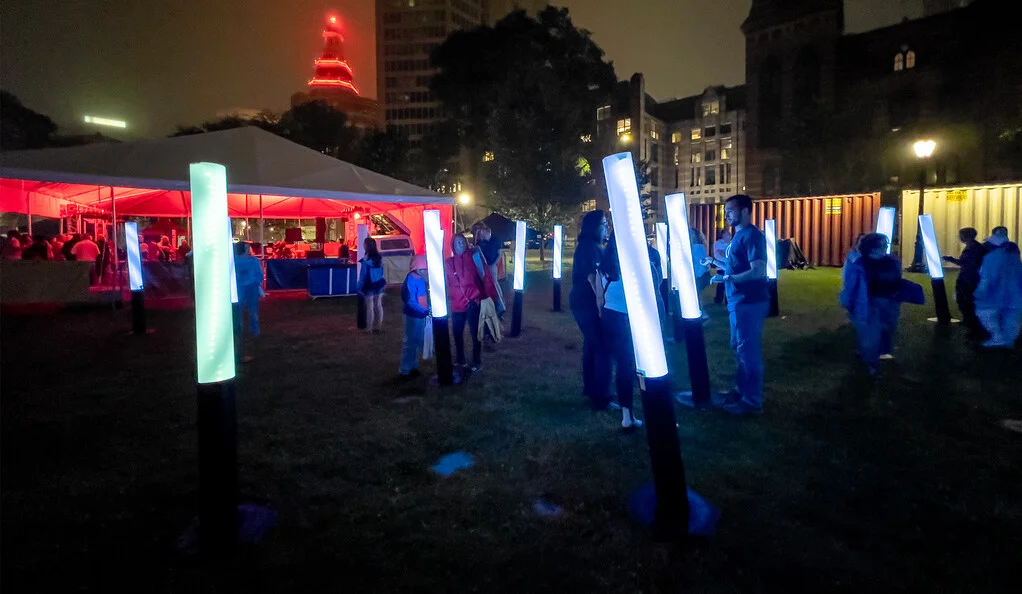
An art installation developed at the Yale Quantum Institute, employing quantum error correction, debuted at the International Festival of Arts & Ideas.
On a foggy, Friday night recently, with old hip hop songs filling the air and hundreds of happy people taking in the International Festival of Arts & Ideas, a small quantum forest sprouted up on the New Haven Green.
Dozens of illuminated beacons, each one 6-feet tall, were spread out in rows, not far from the festival’s main stage. As people walked, danced, and posed for selfies among them, the beacons lit up in blue, green, red, or white.
“Can you tell us how this works?” asked Edward Sullivan, as he and Yvonne Benjamin, both of Shelton, Connecticut, approached Florian Carle, the official tour guide for this mini maze.
“What do you know about quantum physics?” asked Carle, who, in his day job, is manager of the Yale Quantum Institute (YQI).
As Carle explained it, what looked like a random light show was, in fact, the orchestration of a sophisticated quantum computing technology that has taken years to develop — technology that may someday change daily life.
More specifically, the site-specific exhibit, called “Beneath the Green, the Quantum” and created by artist Stewart Smith during his year-long residency at YQI, employs Yale’s latest research into quantum error correction, a concept in quantum computing research that is one of the biggest remaining hurdles in creating full-scale quantum computers that perform calculations an order of magnitude faster than traditional computers.
 Artist Stewart Smith created the site-specific exhibition during his year-long residency at the Yale Quantum Institute.
Artist Stewart Smith created the site-specific exhibition during his year-long residency at the Yale Quantum Institute.
Quantum computers store information as data in the form of quantum bits known as qubits — that are notoriously finnicky and susceptible to errors. Researchers are attempting to correct these errors with additional, “stabilizer” qubits that are interspersed with the “data” qubits. Earlier this year, Yale researchers were able to more than double the lifetime of a qubit, effectively showing that quantum error correction is a practical tool for building quantum computers.
“For this piece, I knew I wanted to work with light and I knew I wanted something that would be meaningful for the faculty and students,” said Smith, a graphic designer who earned his MFA in graphic design from Yale in 2008. “Right now, there are faculty and students here who are working on algorithms to correct qubit errors — they are at the forefront of their field.”
After consulting with YQI researchers, Smith worked with Carle and computer science graduate student Yue Wu to create the conceptual themes and software for the art installation. Alpay Kasal and his experiential design company Bignoodle in San Francisco created the custom hardware.
 Visitors to “Beneath the Green, the Quantum” became participants as well.
Visitors to “Beneath the Green, the Quantum” became participants as well.
The beacons use proximity sensors and custom-built software that runs in a Web browser to allow spectators to become active participants. The movement of each participant through the art installation creates a simulation of quantum errors. The correction software goes to work correcting these “errors,” causing the beacons to change color.
A red light indicates an error has been located; a blue light indicates the error has been resolved. Green and purple lights signal that errors are overwhelming the system.
YQI likely will recreate the installation in the fall, on campus, Carle said.
For now, at the Green, YQI’s quantum forest quickly attracted scientists and non-scientists alike.
“This is, by far, the most ambitious science outreach idea we’ve done,” said A. Douglas Stone, the Carl A. Morse Professor of Applied Physics and Physics, and YQI’s deputy director, as he surveyed the scene. “It has real complexity to it.”
But not too complex for festivalgoers Sullivan and Benjamin, who happily danced their way through the lights after getting their tutorial.
“It was very interesting, especially after getting an explanation about how it works,” Sullivan said. “We didn’t get it at first, until we walked away from the first light, and it turned blue.”
“This definitely helped connect the dots,” Benjamin said.